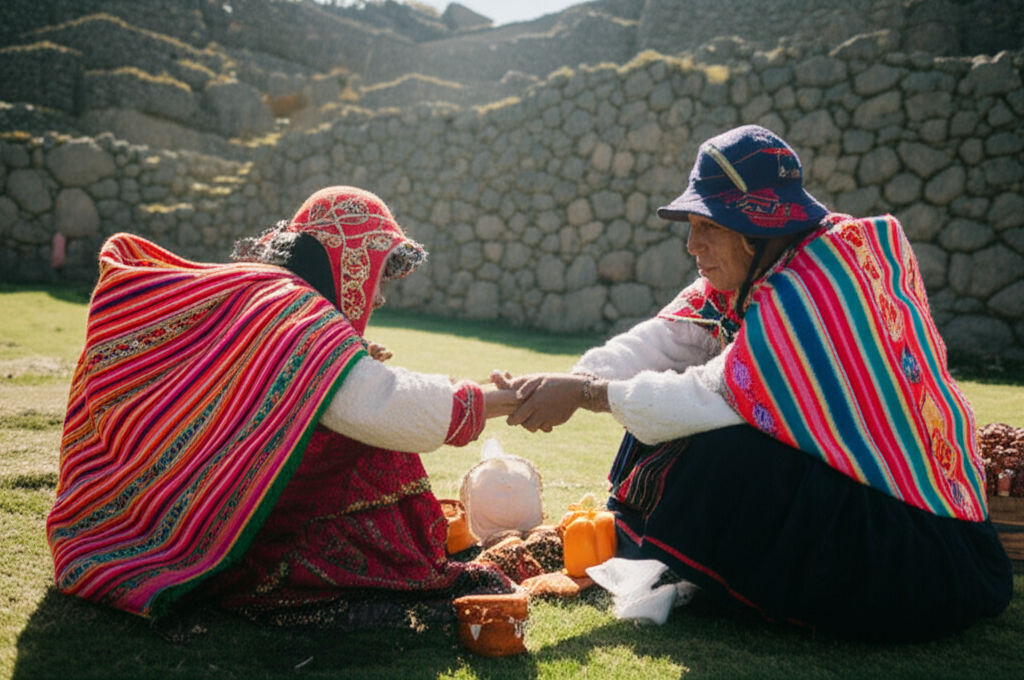Inca Economic System Overview
Ikhsan Rizki

Photo: Explore the Inca Empire's money-less economy. A masterclass in resource management, built on reciprocity, redistribution, and labor, ensuring prosperity.
Unraveling the Inca Economic System: A Masterclass in Resource Management
Have you ever wondered how a vast empire, spanning thousands of miles across rugged mountains and diverse climates, could thrive without money or traditional markets? The Inca Empire, flourishing in the Andes from roughly 1438 to 1532 CE, offers a fascinating answer. Far from being primitive, their economic system was a marvel of organization, efficiency, and sustainability, built on principles that might surprise you.
In a world where currency and commerce dominate, understanding the Inca Economic System Overview provides a unique perspective on how societies can manage resources, distribute wealth, and ensure the well-being of their people through entirely different means. How did they achieve such prosperity and control without the familiar tools of modern economies? Let's delve into the ingenious mechanisms that underpinned this remarkable civilization.
The Foundation of Inca Economy: Reciprocity and Redistribution
At the heart of the Inca economic model were two intertwined concepts: reciprocity and redistribution. These weren't just economic practices; they were deeply ingrained social and political philosophies that shaped every aspect of Inca life.
The Ayllu: A Community Cornerstone
The basic unit of Inca society and its economy was the ayllu. This was a collective of families, often with common ancestors, living together in a village or settlement. Each ayllu owned a marka, or village, and worked the land communally. They developed traditions of solidarity to adapt to the challenging Andean environment.
Reciprocity (Ayni)
Ayni was the principle of mutual aid and balanced exchange. Imagine neighbors helping each other with tasks like planting or harvesting crops, expecting similar help in return when they needed it. This "give-and-take" system fostered strong community bonds and ensured that labor was shared efficiently. It wasn't about profit, but about collective well-being and fulfilling social obligations.
Redistribution
While ayni operated horizontally between individuals and families, redistribution was a vertical system managed by the state. The central Inca government, led by the Sapa Inca, collected surplus goods and labor from the ayllus and then redistributed them as needed throughout the empire. This ensured that regions facing shortages received support, and it also allowed the state to maintain its officials, military, and fund large public works. The Sapa Inca, considered the "son of the Sun," governed through personal relations with local rulers, adopting this concept of "reciprocity" or "exchange."
Labor as Currency: The Mita System
Perhaps the most distinctive feature of the Inca economic system overview was the mita system. Unlike modern taxation based on money or goods, the Inca Empire's "taxes" consisted primarily of labor obligations.
What was the Mita System?
The mita was a system of mandatory public service or labor tribute. Every able-bodied male citizen, typically between the ages of 15 and 50, was required to dedicate a specific portion of his time each year to state service. This wasn't slavery; it was a rotational and temporary duty, considered a communal responsibility and a sacred obligation to the empire.
Public Works and Infrastructure
The mita system was the engine behind the Inca's monumental achievements. Mitayos (workers) were conscripted for various state projects, including:
- Building an extensive road network (Qhapaq Ñan): This vast system spanned thousands of kilometers, facilitating communication and the movement of goods and armies across the empire.
- Constructing agricultural terraces: The Incas ingeniously transformed steep mountain slopes into fertile farmland using terraces, which also helped prevent soil erosion and manage water.
- Erecting impressive temples and administrative centers: Many of the iconic Inca structures we admire today, like Machu Picchu, were built through mita labor.
- Mining precious metals: Gold, silver, and copper were extracted, primarily for religious and elite use, not as currency.
In return for their labor, the state provided essential provisions like food, clothing, shelter, and even ceremonial beer, ensuring the well-being of the workers and their families. This reciprocal arrangement was crucial to the system's success.
Centralized Control and Resource Management
The Inca economy was a highly centralized and planned system, arguably one of the most successful in history. The state meticulously managed resources, ensuring that production met the needs of the empire.
Agricultural Prowess
Agriculture was the bedrock of the Inca economy, sustaining a population that, at its peak, exceeded 10 million inhabitants. They cultivated a diverse range of crops, including maize (corn), potatoes, quinoa, and various vegetables, adapting farming techniques to diverse Andean environments. Innovations like terracing and sophisticated irrigation systems maximized productivity in challenging terrains.
The Role of Qollqas (Storehouses)
A key element of their resource management was an extensive network of storage facilities called qollqas. These stone silos, strategically located near settlements and along the road system, were used to stockpile surplus food and resources. This allowed the Incas to:
- Buffer against erratic weather and potential food shortages.
- Supply the Inca's army and state officials.
- Redistribute goods to communities based on need.
Beyond Agriculture: Textiles and Camelids
While agriculture was primary, the Inca economy also valued manufactured goods. Textiles, especially those made from alpaca and vicuña wool, were highly prized and used for elite clothing and as state gifts. The raising of llamas and alpacas was also vital, providing wool, meat, leather, and transportation for goods across the empire.
Absence of Money and Markets
Perhaps the most striking aspect of the Inca Economic System Overview is the near-complete absence of money and traditional markets. How did goods circulate without them?
Instead of currency, a person's labor was "rewarded with the guarantee of future mutual assistance and social standing." Exchange of goods and services was based on the principles of reciprocity and redistribution. While some localized barter might have occurred, large-scale trade within the empire was not based on a market system. The value of goods and services was often determined by the social and political positions of those involved in the transactions.
This unique approach meant that wealth was not accumulated individually in the form of currency, but rather through collective prosperity and the efficient management of resources for the benefit of the entire empire.
Conclusion
The Inca Economic System Overview reveals a highly sophisticated and centrally organized model that defied conventional economic wisdom. Built on the pillars of reciprocity (ayni), redistribution, and a labor-based "tax" system (mita), the Incas created an empire that thrived without money, markets, or even a system of writing (though they used quipu for record-keeping).
Their ability to manage vast agricultural resources, construct monumental infrastructure, and provide for millions through collective effort and state planning is a testament to their ingenuity. The Inca economy was a complex web of social obligations and efficient resource allocation, demonstrating a powerful alternative to market-driven systems.
What aspect of the Inca economic system did you find most surprising or innovative? Share your thoughts in the comments below!
Business
View All
November 19, 2025
Why Deloitte Is Laying Off ConsultantsUnderstand why Deloitte is laying off consultants. Economic headwinds, post-pandemic overhiring, and shifting client needs are key factors.
Ikhsan Rizki

August 11, 2025
Review of HON Office FurnitureChoosing office furniture? Our HON review covers reliability, affordability, and who it's best for, helping you pick the right fit for your workspace.
Ikhsan Rizki

August 31, 2025
Best Ways to Find Costco Coupons in 2025Unlock maximum Costco savings in 2025! Discover how to find Instant Savings, use the app, and get email deals for ultimate discounts.
Ikhsan Rizki

November 5, 2025
Virginia Business Search Made EasyUnlock Virginia business info effortlessly! Our guide simplifies SCC searches for name availability, due diligence, and company details. Get reliable results.
Ikhsan Rizki

August 14, 2025
Business Lessons from Busy SpiderUnravel the secrets of success! Discover how a spider's strategic web design, persistence, and efficiency can transform your business.
Ikhsan Rizki

September 10, 2025
How to Style a Risky Business OutfitElevate your office style! Master the "risky business outfit," balancing professionalism with a confident, fashion-forward edge.
Ikhsan Rizki
Economy
View AllUnpack "full employment" beyond zero unemployment. Discover its true meaning, impact on the economy, and how it shapes policy. Master key economic concepts.
Ikhsan Rizki
Decatur, GA on a budget? Learn strategies to find an affordable, quality hotel stay. Enjoy your trip without sacrificing comfort or location!
Ikhsan Rizki
Find comfortable, clean, and affordable economy lodges for your next trip. Our guide helps you discover budget-friendly stays near you!
Ikhsan Rizki
Unlock motivation with the power of token economies! Learn the psychology behind this system to drive positive behavior and achieve goals.
Ikhsan Rizki
Upgrade your long-haul flight! Discover ITA Airways Premium Economy: enhanced comfort, more space, and amenities without the business class price tag. Is it for...
Ikhsan Rizki
Is Singapore Airlines Economy a cut above? Uncover its premium comfort, world-class entertainment, and renowned service in this guide.
Ikhsan Rizki
Education
View AllMaster "Physical Education" in Spanish! This guide covers "Educación Física," "EF," and regional variations like "Gimnasia." Speak confidently!
Read MoreDiscover special education teacher salaries! Learn national averages, key influencing factors, and strategies to boost your income in this rewarding career.
Read MoreUncover the UGA Marine Center in Savannah, GA. Dive into groundbreaking marine research, education, and conservation protecting Georgia's coast.
Read MoreEmpower your child's special education journey. An IEE offers an unbiased second opinion to ensure their needs are truly met.
Read MoreShape the future of education! Explore Director of Education jobs, key responsibilities, and career paths for experienced leaders.
Read MoreUnpack why Democratic AGs are suing the Education Dept. Learn the key issues, from student loans to policy, and their impact on American education.
Read MoreHealth
View All
September 24, 2025
Pueblo Community Health ServicesDiscover Pueblo Community Health Services (PCHS): accessible, comprehensive medical, dental, & behavioral health for all in Pueblo. Your guide to quality care.
Ikhsan Rizki

August 24, 2025
LifeStance Health Reviews TodayConsidering LifeStance Health? Get real patient insights. Explore services, reviews, and tips to decide if this mental health platform is right for you.
Ikhsan Rizki

November 6, 2025
Ponce Health Sciences University InfoPonce Health Sciences University (PHSU): A distinguished choice for health education, offering diverse programs, cutting-edge research & community focus.
Ikhsan Rizki

November 29, 2025
San Jose Behavioral ServicesSan Jose behavioral services: Your guide to mental wellness in Silicon Valley. Find local support & thrive amidst life's pressures.
Ikhsan Rizki

October 26, 2025
Follow My Health Northwell Login TipsGet seamless access to your Follow My Health Northwell patient portal. Our guide offers tips to resolve login issues and manage your health records with ease.
Ikhsan Rizki

August 24, 2025
Top 25 Health Science Jobs for 2025Unlock your future! Discover the top 25 in-demand health science jobs for 2025. Find a fulfilling and stable career in healthcare.
Ikhsan Rizki
Popular Articles
View All
1
2
3
4
5
6
7
8
9
10
Lifestyle
View All
November 2, 2025
What is HM Lifestyle on your credit card
Mysterious "HM Lifestyle" charge on your card? Unravel what it means, from H&M purchases to potential fraud, and how to investigate.

September 18, 2025
Life With a Five Million Dollar Net Worth
Ever wonder what life with $5M net worth is *really* like? Uncover the true realities, responsibilities, and financial freedom beyond the luxury.

November 24, 2025
Inside Red Monkey Lifestyle Brand
Red Monkey Lifestyle Brand: Authentic rock & roll style handcrafted in America. Unique, vintage-inspired accessories for those who stand out.

October 1, 2025
The Passage Hotel Is a Must Stay
The Passage Hotel Basel: Your must-stay destination for luxury, comfort, and an unbeatable city center location. Unforgettable travel awaits!

August 13, 2025
Manchester Adult Lifestyle Overview
Unlock your best life in Manchester! This guide covers top neighborhoods, career insights, leisure, and community to help you thrive in this vibrant city.

October 8, 2025
Bose Model 5 Music System
Explore the Bose Model 5 Music System. Get immersive, room-filling sound from a sleek, compact home audio solution. Rediscover your music!

November 8, 2025
Inside the world of Lifestyle Inc
Explore "Lifestyle Inc," the vast ecosystem shaping modern life. Understand its influence, make mindful choices, and take control of your well-being.

November 18, 2025
Are Lifestyles Prices Worth It
Are your lifestyle choices worth the cost? Decode "lifestyle prices" to ensure you're getting true value from your spending.
Sports





Travel
View All
October 31, 2025
Tex Best Travel Center Roadside Stop
Find the perfect pit stop in Texas! Tex Best Travel Center offers clean restrooms, diverse fuel, and food to redefine your road trip experience.

October 4, 2025
EOS Vanilla Cashmere Hand Cream Travel Size
Banish dry travel hands! Get soft, hydrated skin on the go with EOS Vanilla Cashmere Hand Cream Travel Size. Your compact hydration secret.

September 27, 2025
Prayer for Safe Travel
Find peace and protection for your journey. Discover how a powerful prayer for safe travel can reduce anxiety and bring divine peace of mind.

August 5, 2025
Direct Line travel insurance
Direct Line travel insurance: No new policies. Existing customer? This guide helps you manage your policy, understand coverage, & navigate claims.

October 4, 2025
Fellow Travelers Book on Love and Politics
Discover Thomas Mallon's "Fellow Travelers," a poignant novel masterfully intertwining forbidden love with McCarthy-era political paranoia.

November 7, 2025
Lululemon Travel Bag for Active Lifestyles
Elevate your active travel! Find the ultimate Lululemon bag for seamless organization, durability, and style on all your adventures.

















